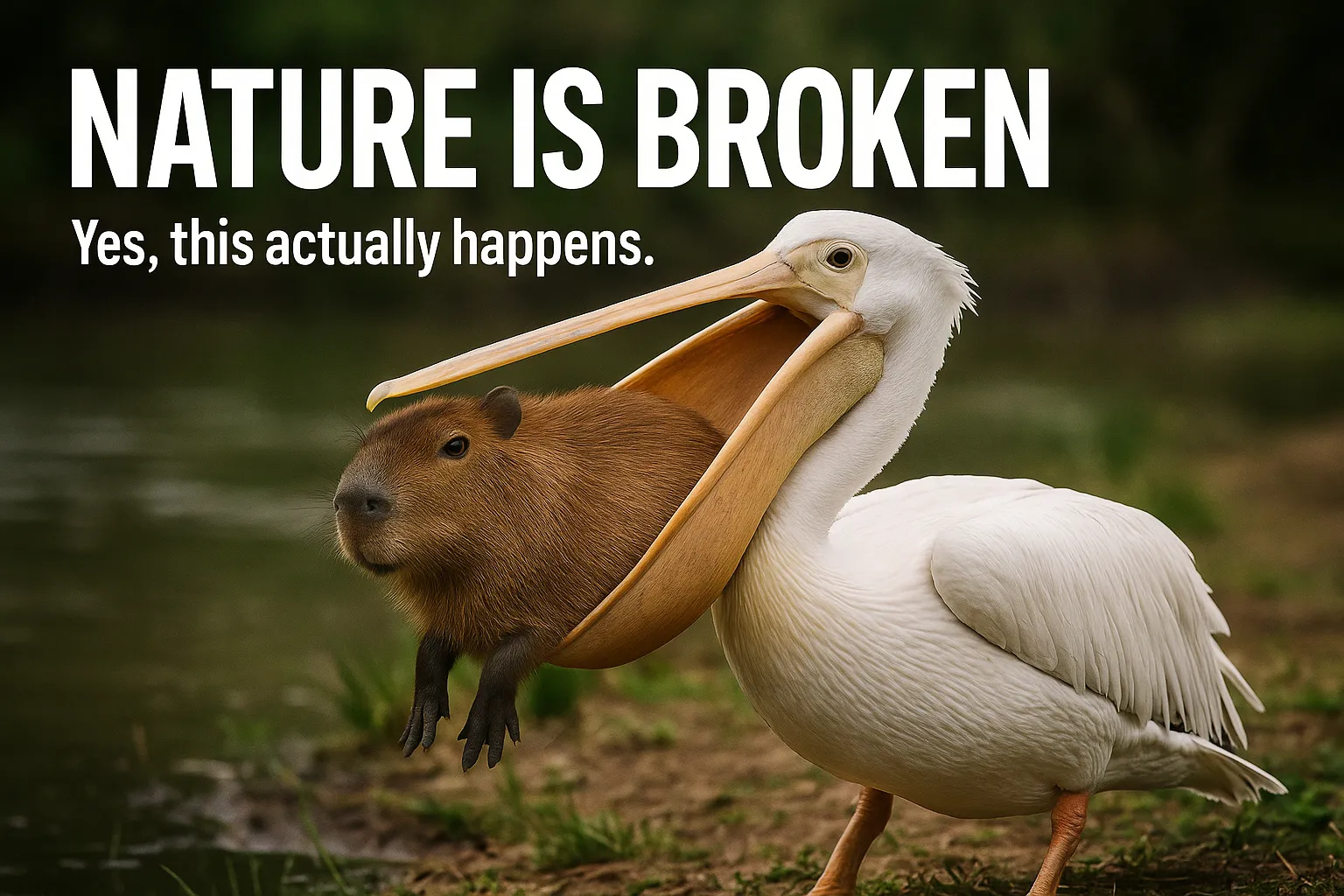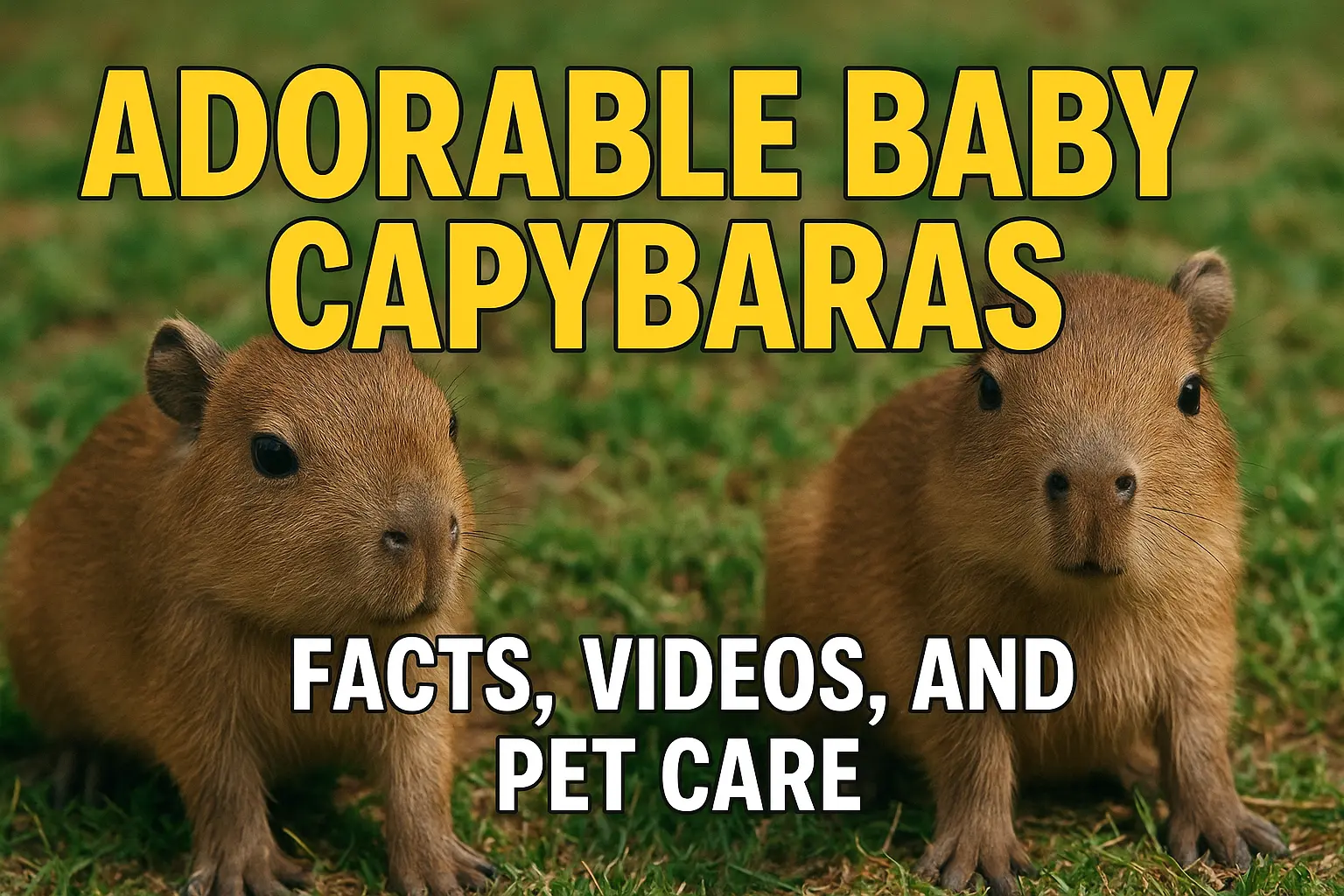
Adorable Baby Capybaras: Facts, Videos, and Pet Care
July 19, 2025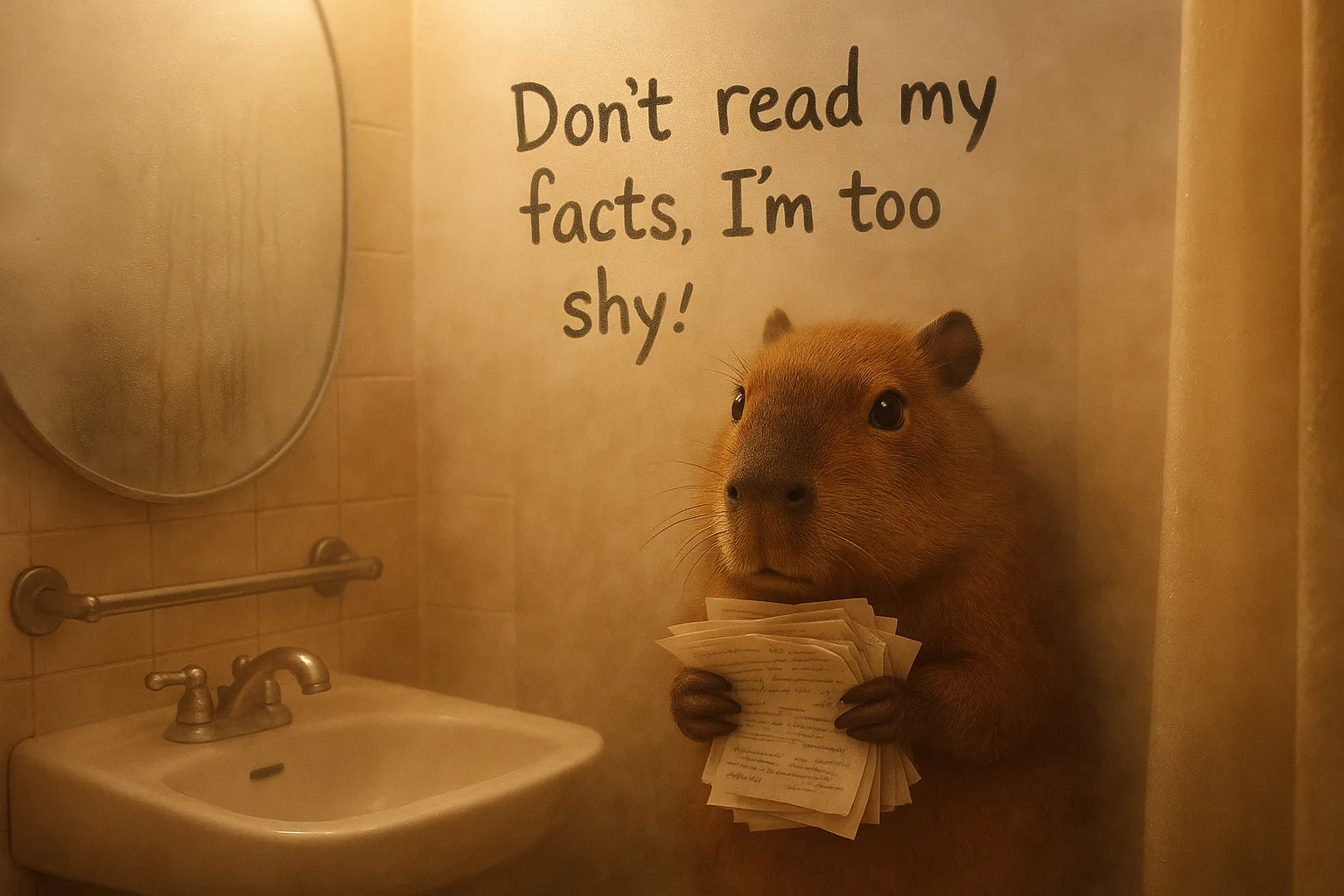
Capybara Facts: Meet the World’s Largest (and Chillest) Rodent
July 19, 2025You might be wondering: Do pelicans really try to eat capybaras? Believe it or not, but not because pelicans are secretly Big Rodent Hunters. It’s because pelicans are voracious, opportunistic feeders with enormous beaks, and sometimes they mistake a capybara (especially a small one) for dinner. In other words, pelicans will try almost anything that looks edible (more on that in a second). Don’t worry, I’ll explain why this bizarre behavior happens – and why it’s usually harmless for big capybaras.
Pelican Diet: Fish, Frogs, and (Occasionally) Big Mouth
Pelicans are carnivorous birds built to catch fish. They scoop up water and prey in their stretchy throat pouches. In fact, American white pelicans “eat mainly small, schooling fish, although they also eat crayfish and amphibians on inland lakes”. Here’s a quick breakdown of what pelicans typically swallow:
- Fish (carp, minnows, salmon, etc.) – usually 0.3–0.9 kg (0.7–2 lbs).
- Amphibians (frogs, toads) – on the order of a few ounces (<0.2 kg).
- Crustaceans (crayfish) – generally under 0.5 kg (<1 lb).
Essentially, pelican prey items are small to medium-sized fish and water critters. They can gulp down surprisingly large things (even whole pigeons or ducklings, as some fishermen have reported), but those are outliers.
Because pelicans fish cooperatively and have huge expandable beaks, anything that fits might get scooped. If a pelican spots something “meaty,” its instincts kick in – even if that “meal” is oddly large. (Think: toddler at a buffet who wants to try everything.)
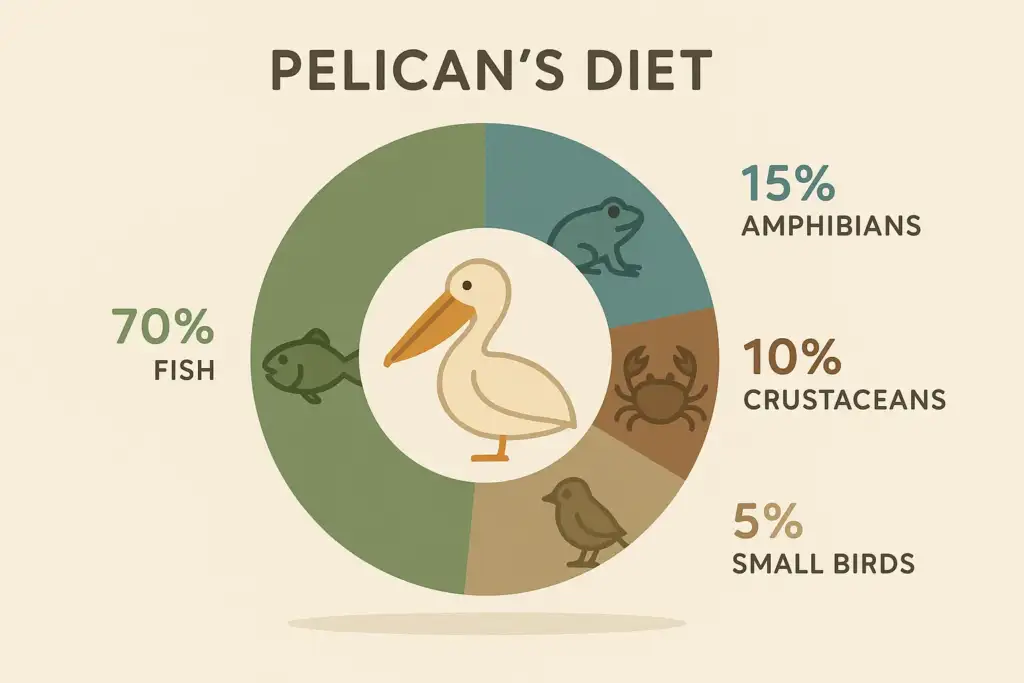
Table 1. Pelican Diet Items vs. Capybara Size. Pelicans normally eat fish and frogs measured in ounces, while capybaras are dozens of kilograms. That’s why pelicans almost always fail at actual capybara dining–they simply can’t stretch enough.
Habitat Overlap: When Worlds Collide
So why do pelicans even encounter capybaras? In parts of South America, pelicans and capybaras share the same wetlands, rivers, and lakes. In those lush, biodiverse habitats, food can sometimes be scarce or unpredictable. Capybaras — the world’s largest rodents – often laze by the water, and curious pelicans swim by. If a capybara looks vulnerable or alone, a hungry pelican might get inquisitive.
When fish stocks dip or a pelican is especially hungry, it might expand its menu. Experts note that during food shortages, pelicans “might expand their diet to include non-traditional prey, such as young or small capybaras”. In plain speak: Pelicans are opportunists. If it quacks like a snack (or walks by looking like a big fish), pelicans will give it a shot.
- Mixed signals. In murky water or from afar, a small capybara might look like a large fish or amphibian. The pelican’s first instinct is to scoop!
- Poor eyesight (at times). Pelicans catch fish mostly by touch and reflex. So the first grab can be a surprise for both parties.
- Overconfidence. A pelican might think, “If I just get it in my beak, I’ll figure it out.”
Pelicans Are Opportunistic (Even Clueless) Feeders
Here’s the deal: Pelicans will try to eat almost anything that fits in their mouths. If they’re hungry or confused, they don’t think twice. As one Redditor put it, “Pelicans try to eat everything. Like toddlers. They see something that looks edible, and they try to eat it.” That hilarious truth helps explain the capybara clips: the pelican isn’t targeting capybaras specifically, just applying the “scoop anything that moves” rule.
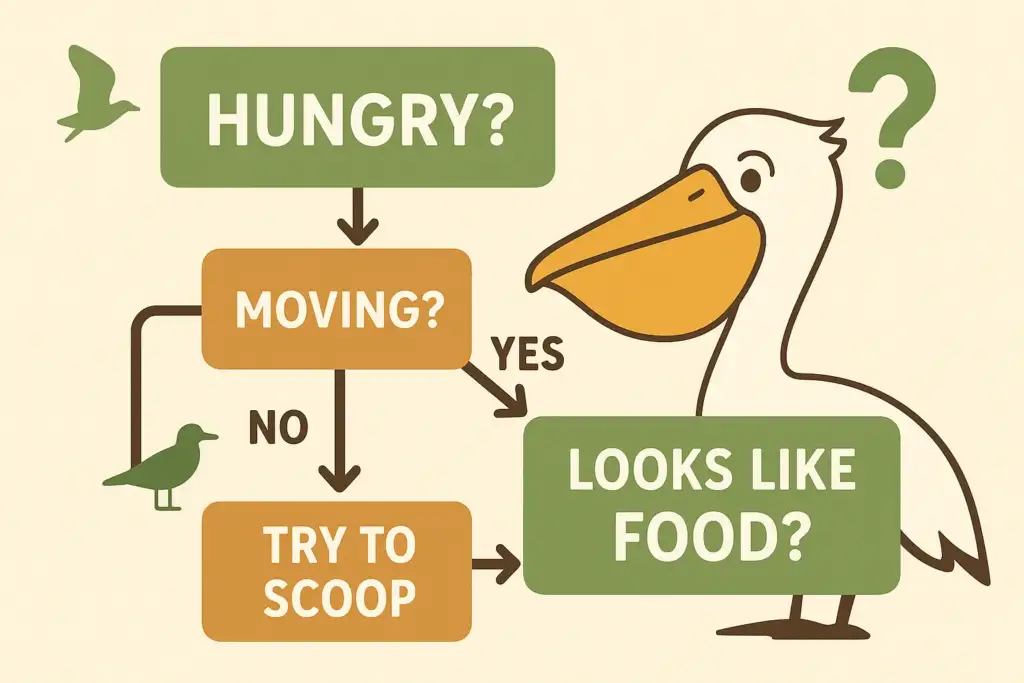
Another user bluntly declared, “Pelicans are dicks!” – in the friendly Reddit sense – because of this bold behavior. It’s funny but telling: pelicans are aggressive about feeding, but not malicious. They’re “confident” feeders with big mouths and small brains about what to put in them.
Capybaras’ Countermeasures: Zen and Swim
So what does a capybara do when a pelican goes for it? Mostly, laugh it off. Adult capybaras are huge (35–65 kg) and often unbothered by a bird with a beak (as long as the bird doesn’t get it in its pouch). Capybaras are excellent swimmers and quick to dive, giving them an escape route that birds like pelicans can’t follow easily. They also live in groups, and there’s safety in numbers.
Some capybara observers note that the big rodents often just sit calmly (or nonchalantly groom), even if a pelican makes a move. As one Reddit commenter joked about a viral clip, the capybara looks “Zen and unfazed”, practically meditating while the pelican freaks out with its pouch. Another quipped, “Capy straight up didn’t care.”. In short, capybaras usually shrug this off; they know their size advantage.
Still, baby capybaras (much smaller and still developing) could be at risk if a pelican really tries. That’s why pelicans might target younger or smaller rodents if they see them. But mature capybaras are almost always safe: a pelican’s expansion skills have limits, and a capybara’s underwater getaway plan is hard to beat.
Are Pelicans Dangerous?
Now, “Are pelicans dangerous?” is a natural question. Good news: No, pelicans are not generally dangerous to people or large pets. In fact, they’re pretty gentle as far as wild birds go. Pelicans have no teeth and relatively weak bite strength – their big bill is designed for scooping water, not chomping tough meat. (Some bird experts note that being bitten by a pelican feels like getting a book slammed on your hand!)

On the downside, a pelican can accidentally injure small animals (think: a tiny dog or cat left alone near the water) if it tries to swallow them. There are a few viral stories of pelicans snatching small pets; these are tragedies for the pet but rare for humans. For the most part, pelicans focus on fish and easy snacks and are “extremely docile birds” that “rarely come into contact with people”.
Wildlife guides confirm that American white pelicans often loaf near humans without issue. If you see one waddle up, it’s probably hoping you have fish (nope, don’t feed it!). But they’re unlikely to attack you or a fully grown pet.
Pelican vs. Capybara: Size Showdown
Just to underscore how mismatched this is, consider the numbers one more time. Adult capybaras weigh around 35–65 kg (77–143 lbs). Even a small juvenile is far larger than any normal pelican snack. Comparatively, the pelican’s prey, fish and frogs, range in weight from a few ounces to several kilograms. That’s like trying to eat a whale when you’re used to tuna!
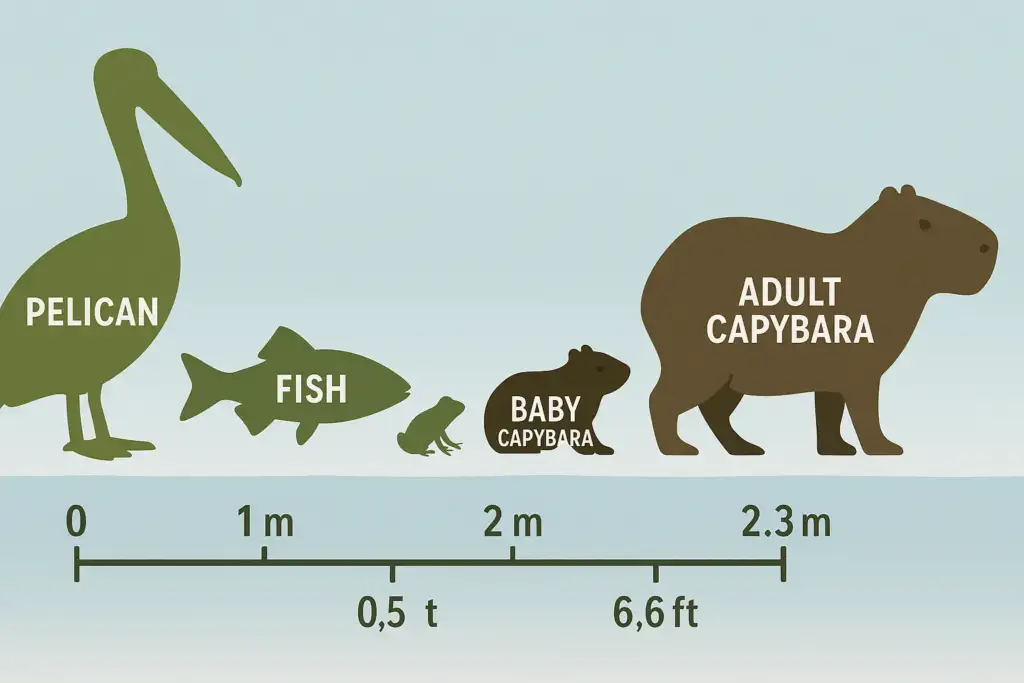
It’s no wonder that no one has ever seen a successful pelican capybara meal. Every clip is the bird failing: it gets a snout or paw in its beak, panics, and the capybara usually just shakes free or wades away. Funny enough, this “failed dinner” is exactly why people find the videos so hilarious.
One Reddit observer even said it’s “one of the best things I’ve ever seen on the Internet”–all thanks to a calm capybara and a very embarrassed pelican.
Internet Reactions (Memes and All)
Of course, the internet had a field day. Memes and jokes abound:
- “Pelicans try to eat everything, like toddlers…” summed up many responses.
- Capybaras get their own memes: one Redditor captioned a scene, “the capybaras like ‘ugh not this shit AGAIN’”.
- Another quipped, “Pelicans are, umm, ambitious.”
People also chimed in on Q&A sites. On Quora and Reddit alike, the consensus is “pelicans just thought capybaras were fish” (in a manner of speaking). One answer bluntly said pelicans would happily eat a capybara if it were small enough, highlighting that size is the only real obstacle.
Bottom line? The internet finds it hilarious and harmless, and wildlife fans use it as a reminder: nature can be weird and wonderful. 🦩
Have you ever seen a wild animal act totally out of character? Share your stories or memes in the comments below–I’d love to hear your reactions!
FAQs About Capybaras (Quick Answers, No Fluff)
Why do pelicans try to eat capybaras?
Pelicans are opportunistic feeders. They see anything vaguely meaty and go for it. In overlapping habitats (South American wetlands), a small or young capybara might look like a big fish or frog. Hungry pelicans will briefly attempt it, and then quickly realize their mistake.
Can a pelican actually swallow a capybara?
No, adult capybaras are far too large. Pelicans typically catch prey that’s only a few kilograms at most. An adult capybara (35–65 kg) would be physically impossible to swallow. Even baby capybaras are usually too big. Pelicans simply aren’t built to eat something that heavy.
Are pelicans dangerous to humans or pets?
Generally, no. Pelicans are mostly harmless to people and large animals. They have weak, toothless beaks and avoid confrontation. However, small pets (like kittens or puppies) could be snatched by a very determined pelican if left near water, since the bird might try to eat anything that moves. Keep pets supervised, and you’ll be fine.
Why do pelicans seem to try to eat everything?
Pelicans have giant beaks and a reflex to scoop up anything edible in the water. They can’t inspect things closely before grabbing them – they basically “give it a taste.” That’s why they’ve been caught on video attempting to swallow things like strollers, bottles, rocks, or, famously, capybaras. It’s curiosity and hunger at work more than intent to harm.
What should I do if I see a pelican attacking a small animal?
If you can safely intervene (say it’s a small pet), gently distract or scare the pelican away – they dislike loud noises. But don’t try to grab a pelican; they can flap and squawk or peck in defense. Usually, pelicans let go quickly if disturbed. Remember, it’s acting on instinct, so try not to hurt it either.
Why are we seeing so many pelican-capybara videos now?
Viral clips often trigger similar content. Once one pelican vs capybara video went viral, others followed (you can find a few on TikTok and YouTube). Capybara enthusiasts and bird fans started sharing them. It’s a novelty that’s funny and surprising, so it keeps reappearing online
Are capybaras at risk from other predators?
Yes, but mostly big cats and caimans. Capybaras have more natural predators (jaguars, pumas, crocodilians, large snakes, and birds like caracaras or vultures). Pelicans could attempt a snack in rare cases, but capybaras are generally safer from birds than from the usual suspects.
Ready to weigh in? Have questions about pelican behavior or capybaras? Drop a comment below–I’m here to chat about these wild encounters!
Sources: Animal Diversity Web, National Geographic, and real Reddit/Quora community discussions.

